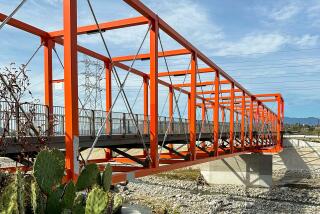Wondrous connections
- Share via
We don’t often give the world of structural engineering a second glance. Whether holding up a building, burrowing underground or restraining billions of gallons of water, most skyscrapers, subways and dams simply go about their business and allow us to go about ours. In this way, bridges are no exception. Even with audio-visual clues such as the ubiquitous expansion joint, we often fail to notice the bridge below us as we hurtle along in search of the next rest stop or speed trap.
Belonging to the same family as the humble highway span, however, are a significant number of considerably more outgoing and ambitious structures who work just as hard, but at the same time want to be appreciated for their efforts. These are the bridges that catch our breath and stir our imaginations. With their seldom surpassed combination of beauty and utility and often overwhelming scale, they seduce us into paying attention.
Some of them are monuments rising from hidden footings, deep within the walls of a towering ravine or stretching across an impossibly wide river as if placed there by a giant model railroad enthusiast. Others are small, built (and then covered) by the local carpenter to get to grandmother’s house. All symbolize the melding of vision and determination in a crucible of courage and hardship, and all have become part of our psyche.
Bridges are among the most revealing and generous examples of the structural engineer’s work. They are skinless buildings. In their unabashed nakedness, they allow us to appreciate the means by which they accomplish their extraordinary feats. As the physical representation of countless solutions, they also suggest the very problems with which their creation began. Most significantly, they recall the vexing requirement of getting from point A to point B when getting from A to B isn’t easy. But each also embodies the answers to such questions as: What is the bridge intended to carry? How quickly must it be built and how long should it last? What materials are available and what are the financial resources? The resulting geometric configuration is the ultimate solution, the sum of all the answers.
In “Bridges: The Spans of North America,” David Plowden helps us understand the link between the remarkable solutions we see before us and the range of problems out of which they grew. By combining his original photographs with detailed engineering drawings and engaging essays on the historical evolution of various bridge types as well as the building of specific bridges, we begin to understand the process behind the structures we so admire and to appreciate the efforts of those behind them. Because bridges invite observation, they also encourage scrutiny.
Plowden’s beautiful and beautifully reproduced photographs offer both the big picture and the details -- helping us recognize and appreciate the aesthetic and practical differences between choices of shapes and materials.
Many of the examples he includes may be unfamiliar. Even when he shows us an old friend, he does so in a way that allows us to think about it differently. The Golden Gate Bridge is part of its moody landscape, while the Brooklyn Bridge is presented as a web of cables drawn in silhouette.
As we read Plowden’s book, we come to realize that each new bridge is a unique creation. Even when one bridge replaces another, the requirements, opportunities and limitations facing the engineer will probably be different. Perhaps it must carry trucks instead of locomotives or there are new materials and design methods available that will significantly reduce cost without compromising its performance, and so on.
Every bridge begins as an exercise of imagination and daring. Perhaps it is this aspect of bridges and bridge design that most accounts for their appeal both as objects of admiration and opportunities for metaphor. Those of us still struggling to locate that “bridge to the 21st century” we heard so much about, can take solace from the examples in Plowden’s wonderful book. It turns out that every bridge, no matter how grand or how modest, regardless of its shape or the material of which it is built, stands on a foundation of enlightened common sense.


